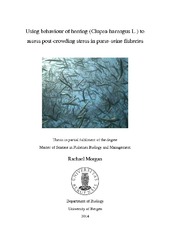| dc.description.abstract | Within the purse-seine fishery crowding fish at high densities, during the process of slipping, has been shown to cause high mortalities. Mitigation measures are therefore needed to enable fishermen to avoid slipping fish, particularly when they have a low survival likelihood. Providing a means of assessing the welfare of the catch may provide a solution and behaviour has the potential to be used as an immediate welfare indicator. The behavioural effects of crowding Atlantic herring (Clupea harengus) in purse-seines were analysed from video-footage collected in large-scale field survival experiments. Crowding densities ranging from 1.5-351 kg/m^3 were simulated to represent the final stages of purse seining and the process of slipping. A detailed and systematic analysis of several behavioural metrics, describing swimming activity and orientation, is described, including tail beat frequency and amplitude, swimming mode, vertical and horizontal orientation and nearest neighbour distance. Tail beat frequency increased with crowding density and was strongly correlated with mortality. This, combined with a decrease in tail beat frequency from the start to the end of the experiment, suggests that high crowding densities may cause fish to swim to exhaustion. Swimming patterns within each cage were diverse and tail beat amplitude was also exceptionally high compared to other studies. Captivity effects may have impacted some aspects of herring behaviour, as orientation showed unexpectedly large variance across all crowding densities and poor alignment, suggesting a lack of schooling. The occurrence of extreme orientations increased over the duration of the experiment, possibly due to increasing sea bird predation. Orientation did not appear to be influenced by crowding density. Tail beat frequency seems to have the best potential as an indicator of subsequent mortality | en_US |
